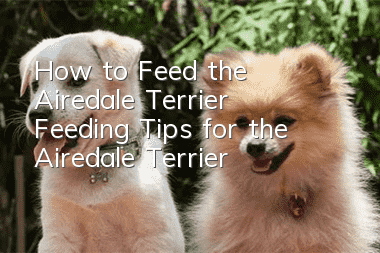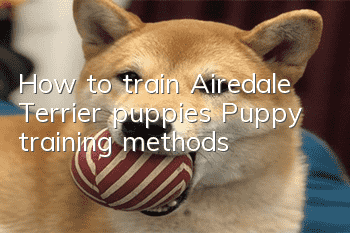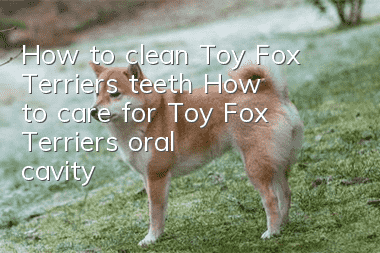How to Feed the Airedale Terrier Feeding Tips for the Airedale Terrier

How to feed the Airedale Terrier? There are methods and techniques for feeding the Airedale Terrier. They should be distinguished according to the age of the Airedale Terrier. One cannot blindly "one size fits all". Below, the editor will share with you about the Airedale Terrier. Feeding points for Terriers.
The young period of the Airedale Terrier is the main stage of growth and development. The body grows rapidly, so sufficient nutrition must be provided. Generally, the body and weight mainly increase in the first 3 months after birth, the body length mainly increases in 4 to 6 months, and the height increases after 7 months. Therefore, different diets should be formulated according to different development stages. Puppies after weaning often appear restless, have a loss of appetite, and are prone to illness due to sudden changes in living conditions. The feed selected at this time should be palatable and easy to digest.
Puppies under 3 months of age should be fed at least 4 times a day. For dogs with poor appetite, the method of feeding first, then the good ones, and feeding less often can be used. Feeding food first, then food first, can keep the dog's appetite strong. Feeding less and more frequently can make the dog always feel not full and prevent it from being tired and picky eaters.
Puppies under 3 months old should be fed porridge, milk or soy milk with appropriate amounts of chopped fish, meat and chopped and cooked vegetables. In order to reduce feed costs without affecting the nutrition of puppies, organs such as pig and cow lungs can be cooked and chopped, mixed with vegetables, cornmeal and other cooked foods, and then fed to dogs. This is economical and dogs love to eat. . Some people think that feeding dogs all meat will make them strong. In fact, this is a wrong approach.
Puppies aged 4 to 6 months have increased food intake and rapid weight gain. The amount of daily feed required also increases, and they should be fed at least 3 times a day. Dogs after 6 months old can be fed twice a day - the puppy's diet should be fed according to the original dog owner's diet first, and then gradually changed.
Eating all meat not only does not make dogs strong, but also causes diarrhea in most dogs due to indigestion and difficulty in absorption. Although meat contains a lot of protein, it contains less vitamin A, vitamin D, vitamin E and vitamin A. At the same time, meat contains less calcium and more phosphorus. Long-term eating of meat can easily cause bone formation disorders in puppies due to an imbalance in the calcium and phosphorus ratio. Limbs are prone to breakage or crookedness. For large dogs such as Great Danes, it is not advisable to feed large amounts of meat too early, otherwise it may cause the forelimbs to bend. Water is absolutely indispensable when raising puppies. A basin of water should always be placed in a fixed place so that it can drink freely before and after eating and exercising.
If the dog can drink enough clean water from an early age, it can develop normally and have a healthy gastrointestinal health. Especially in summer and autumn, the weather is hot and the water in the body evaporates quickly, especially for active puppies. If the water is not replenished in time, it can easily cause water shortage in the tissues, and even cause dehydration, which will affect the dog's health. It is best to give it every time After daily exercise, let the dog drink some glucose water.
Puppies should be fed calcium powder and vitamins, which are necessary for the growth of teeth and bones. Especially purebred dogs with larger skeletons, such as Boxers, Great Danes, etc., need more calcium when they are puppies. Usually for growing puppies under 1 year old, dailyThe amount of calcium powder is about 1 teaspoon for every 2 kilograms of body weight. As age increases, the dosage of calcium powder should be increased proportionally. After 1 year old, as the dog has entered the mature stage and the growth of teeth and bones has stabilized, the demand for calcium powder is relatively reduced. The dosage is about 1 teaspoon of calcium powder per 4.5 kilograms of body weight per day. However, there should be an appropriate amount of outdoor exercise every day and exposure to ultraviolet rays to facilitate the absorption of calcium. Too much calcium powder can be harmful rather than helpful. In terms of feeding and management, puppies require more energy from their owners than adult dogs. Special attention should be paid to preventing a few puppies from overeating, leaving other puppies without enough to eat. The daily food intake of each dog should depend on the size of the dog, which depends on the observation of the breeder.
Pet food experts remind you: You can tell how full or hungry a dog is by looking at its food intake. If the dog eats quickly and swallows in big mouths, it means there is no problem with appetite; after eating, there is food left in the food bowl, indicating that it has fed too much and may be overly full; if the dog continues to lick the empty food bowl with its tongue, or with expectation He looked at the owner with his eyes, indicating that he was not full. It is not advisable to overfeed puppies, it is best to be 70 to 80% full. In addition, since the gastrointestinal tract of puppies is still in the process of development, more attention should be paid to hygiene to prevent gastrointestinal diseases.
- How to train a Toy Fox Terrier to pick up things Tutorial on training a Toy Fox Terrier to pick up things
- What to do if the Toy Fox Terrier barks? How to train the Toy Fox Terrier to stop barking?
- What medicine is good for a Toy Fox Terrier with a cold? What are the symptoms and treatments for a Toy Fox Terrier cold?
- Is the Airedale Terrier easy to raise? How to raise the Airedale Terrier?
- What are the symptoms of Toy Fox Terrier gastroenteritis? What are the symptoms of Toy Fox Terrier gastroenteritis? How to treat Toy Fox Terrier gastroenteritis
- What to do if your Airedale Terrier has an injured foot How to treat an Injured Airedale Terrier's foot
- How to bathe a Toy Fox Terrier? Toy Fox Terrier bathing process and key points
- How to trim bloodhound nails How to trim bloodhound nails
- How to feed Wirehaired Pointing Griffon Dogs What are the feeding points for Wirehaired Pointing Griffon Dogs?
- How to Clean Bloodhound Teeth How to Care for Bloodhound Oral Care



